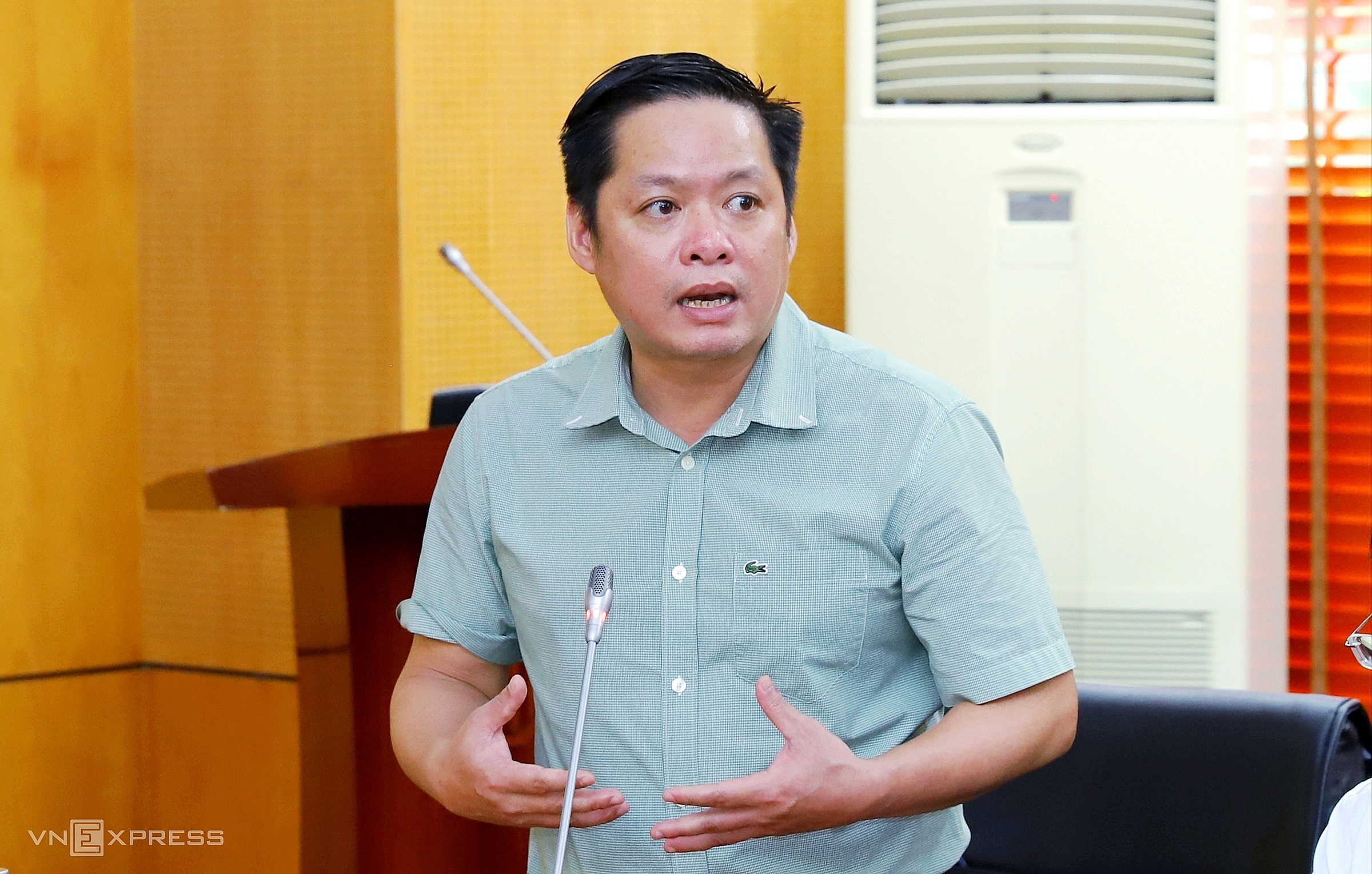The Ministry of Home Affairs is seeking public feedback on the draft amendments to the Law on Public Employees. The draft introduces several groundbreaking policies in management, recruitment, and evaluation of public employees. VnExpress interviewed Nguyen Tu Long, deputy director of the Public Servants and Officials Department, about the draft law.
After nearly 15 years of implementation, what are the biggest limitations of the current Law on Public Employees, and what core issues are these amendments expected to address?
The draft law comprises six chapters and 42 articles, a reduction of 20 articles compared to the current law. It focuses on comprehensive innovation in the recruitment, management, and utilization of public employees. Current recruitment regulations haven't kept pace with the need for organizational reform and integration between the public and private sectors. They haven't effectively attracted and utilized experienced and talented individuals in the public sector. The current examination and recruitment processes are cumbersome and don't accurately reflect the required competencies for specific positions.
Classifying public service units based on their financial autonomy doesn't accurately reflect the nature of public service delivery according to their functions and tasks, leading to unsuitable specific policies. Applying uniform financial and personnel management mechanisms based on this classification creates inequities among units and discourages reform.
This amendment aims to meet the increasing demands of the public, placing public employees under pressure from competition from the private sector and society's stringent requirements.
 |
Nguyen Tu Long, deputy director of the Public Servants and Officials Department. Photo: Trung Kien |
Nguyen Tu Long, deputy director of the Public Servants and Officials Department. Photo: Trung Kien
The draft expands the rights of public employees, including the right to practice their profession outside their public service unit. How will the objectives and safeguards against conflicts of interest be designed?
We aim to maximize the rights of public employees to unleash their potential and increase their income. Public employees can sign contracts to perform professional activities outside their current unit. However, each person can only be a public employee at one agency to avoid conflicts of interest. They can also guest lecture or provide contractual services at other units.
The current law allows public employees to sign contracts with other agencies or organizations if they have completed their assigned tasks and have the consent of the head of their public unit. This approach turns the right to practice one's profession into a "request-grant" relationship, limiting flexibility and failing to recognize it as an inherent right of public employees.
The draft amendment clarifies this, allowing public employees to sign contracts for occasional or regular work outside their agency, as long as it doesn't conflict with their primary contract. This shifts the mindset from "asking for permission to work" to "being allowed to do what isn't prohibited by agreement," recognizing the skills of doctors, teachers, and other professionals as valuable "labor commodities" that should be utilized.
This change fosters competition among units to retain high-quality personnel. A hospital wanting to retain skilled doctors must offer competitive salaries and benefits to maintain its "exclusive brand." This compels units to become more autonomous and develop further while increasing the value of public employees in the job market. As a result, public employees are motivated to develop professionally and provide better services to the public, rather than focusing solely on career advancement.
The draft law also amends and institutionalizes Resolution 57, allowing public employees to invest in, establish, and manage businesses founded by their units or participate in establishing businesses to commercialize research results and products. They can also invest in and develop technology at domestic and international businesses. For creative activities and scientific research with high risks, the draft considers exemptions and reductions of liability in certain cases to encourage innovation within legal boundaries.
 |
Staff working at the Da Nang Administrative Center, 5/2025. Photo: Nguyen Dong |
Staff working at the Da Nang Administrative Center, 5/2025. Photo: Nguyen Dong
The draft also removes professional title "ranks" from the law. How will the new approach based on job positions operate, linked to salaries and contract termination mechanisms?
The draft law removes rank classifications from the law itself, delegating them to government decrees. This aims to avoid burdening public employees with procedures for rank promotion exams when the nature of their work remains unchanged. Within public service units, there will be three position groups: leadership and management; professional and technical (professional titles); and support (accounting, personnel work, etc.). Salaries will be based on job position, competency, and performance, rather than "rank." Those who perform well will be rewarded accordingly, reducing bureaucracy and limiting negativity.
Under current regulations, even if their work remains the same, public employees must go through complex procedures for rank promotion, wasting time and effort. For example, a secondary school math teacher, even after being promoted from rank 3 to rank 2 after an exam, still teaches math daily with the same curriculum and tasks as before.
Public employee evaluation will follow the principle of "in, out, up, down;" the results will serve as a basis for planning, training, and appointment. Specific evaluation methods (KPI, 360-degree, etc.) will be determined by each public service unit within the criteria framework issued by the specialized management ministry.
Regarding contract termination, the draft removes the condition of "two consecutive years of failing to fulfill duties" for termination, adopting an approach similar to labor contracts. If duties are not fulfilled or the employee is not suitable for the position, the contract can be terminated. In specialized fields like circus performance, where performers may find it difficult to continue at age 35-40, there will be mechanisms for job transition or new recruitment. Compensation for training costs if the employee does not return to work will be handled as a civil liability, avoiding situations of "frozen" positions.
In the context of competition for high-quality human resources, what recruitment innovations does the draft amendment introduce to attract talent, especially from the private sector and international sources?
We aim for flexibility and facilitate the movement of human resources between the public and private sectors, in line with the implementation of the Politburo's Regulation 68 on private sector development. The draft maintains competitive recruitment exams and selection processes but adds non-competitive selection for exceptional cases to increase flexibility.
The law allows for the recruitment of experienced individuals from the private sector and allows public service units to sign labor contracts for professional and technical work, rather than solely recruiting public employees based on allocated positions.
The draft also expands the pool of eligible candidates to include Vietnamese citizens living abroad or foreigners residing in Vietnam in specialized fields requiring high-quality personnel. This remains within limits and complies with regulations from competent authorities, especially in fields related to national defense and security.
What are the current shortcomings in classifying public service units linked to public employee management, and what will the new approach be? How will decentralization and empowerment be promoted to link autonomy with accountability?
Currently, classification is based on the level of financial autonomy as outlined in Decree 60 (amended by Decree 29). However, the proportion of group 1 units (highest autonomy) is very low, only about 300 out of 90,000 units. Most belong to group 3 (the state compensates for the difference between revenue and expenditure) and group 4 (the state covers all expenses). Group 1 units have the greatest autonomy in recruitment, salaries, bonuses, and investment, but they represent a very small percentage. This requires further research to identify the causes and increase autonomy, aligning with Resolution 19 on innovating the organization, management, and operational efficiency of public service units.
There are many shortcomings in the current models: group 3's budget allocation mechanism is unreasonable, not encouraging revenue increase but tending towards expenditure increase, causing difficulties for public financial management. Group 4 needs review and should only include units providing truly essential services.
The new approach is based on the nature of operations. Essential services will be managed by the state, while those that can be socialized will be, creating fair competition between the public and private sectors. This will determine suitable service delivery methods and management approaches, consistent with financial autonomy principles, aiming to optimize human resource management.
Concurrently, the draft promotes maximum decentralization and empowerment for public service units, especially those with high autonomy. The greater the financial autonomy, the greater the authority. For group 2 (autonomous in recurrent expenditure), the draft only sets a minimum number of public employees; the unit can decide how many to recruit if it can cover their salaries. We are also exploring granting recruitment authority to all public service units, regardless of their autonomy level, as those directly using the personnel can best select individuals who meet job requirements.
If a unit cannot organize its recruitment or the number of recruits is too small, the higher-level agency will handle it. The regulations also exclude fields with specific laws to avoid legal conflicts. The ultimate goal is to create a flexible recruitment mechanism to attract and effectively utilize public employees, workers, experts, and scientists. Autonomous units can operate almost like economic entities with greater decision-making power in human resource management while ensuring adherence to principles of public service, accountability, and most importantly, the quality of public services delivered.
Son Ha












